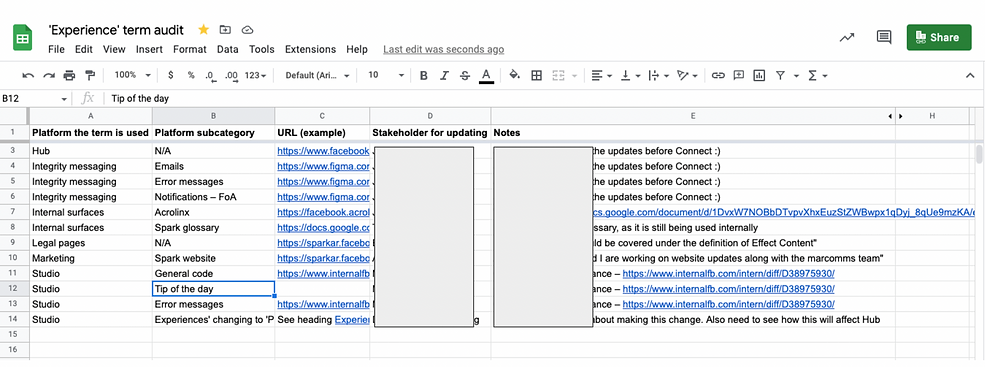Updating language across a product ecosystem




Summary
As a Content Designer at Spark AR (Meta Reality Labs), I led the project that resulted in Meta using the term ‘experiences’ to describe the 'things' that creators make for the metaverse.
The new product and the new term were used during Meta Connect 2022 event, presented by Mark Zuckerberg.
In time, this term could be used by hundreds of millions of people.
The problem
Meta is now shifting its focus towards the development of metaverse. So, our team decided to launch a new type of product, called 'virtual objects'. Virtual objects are described as 'the building blocks of the metaverse'. Virtual objects are set to be the flagship product within the Spark AR ecosystem.
With the launch of virtual objects, I realised the existing language throughout our ecosystem would become outdated. We needed a new, overarching umbrella term to describe all the "things" that creators could make.
On top of that, we needed to roll out all the proposed changes within 6 weeks, before the Meta Connect 2022 event.
My approach
1. Problem statement and taxonomy mapping
In order to organise my thoughts, I decided to write a problem statement:
"At the moment, the only thing a creator can make in Spark AR Studio is an 'effect'. But now we're introducing 'virtual objects', not everything a creator makes will be an ‘effect’ – some will be ‘virtual objects’."
Therefore, we need a new umbrella term to describe “anything a creator can make in Spark AR Studio”.
This new umbrella term would help us describe our products in a more scalable, consistent way.
Taxonomy mapping
I found it useful to create a taxonomy map to help explain these ideas in a visual way:
Before (old taxonomy)
Here, "effect" was used predominantly.
After (new proposed taxonomy)
(Red circle, left) New parent concept to describe everything a creator can make.
"Virtual objects" and "effects" now move to the level below, becoming subcategories of the new term.


2. Understand the scope of the problem
I identified where in our ecosystem we would have to implement the new term:
-
Spark website and Spark AR Hub (the content management hub for AR creators)
-
Notifications – emails, Facebook and Instagram app notifications
-
Within the Spark AR Studio software – UI text, tooltips, error messaging, etc.
-
Educational help and support content
-
Social media community groups and forums
-
Internal language used by staff
-
... Even the language used by end consumers. For example: “Did you see that [thing] on Instagram?”
Below are some visual examples of where the language would need to be updated:

Content management hub
Spark AR Studio (software)
Notifications
3. Considerations
Now that I had a good idea of the problem, I had several questions and considerations in the naming process. For example:
-
Who is the audience?
The audience for this term is the AR content creator. But ideally the term could also be used by end consumers (e.g. Instagram users).
-
How will this term be used?
This is an umbrella term which should encapsulate everything from: effects, virtual objects, group calling and games. It would ideally also cover future use cases that don't exist yet.
-
Is it a proper noun?
This term is technically a feature of a product, not an official Meta product. So it would be a common noun, and not be capitalised (e.g.: “to make awesome creations, you should...”)
4. Namestorming and shortlisting
Next, I organised a namestorming workshop with Product Managers, Engineers, Researchers, Marketing Managers and other Content Designers.
During the workshop, we came up with a list of over 40 potential new terms.
We then voted on our favourites, cutting the list down to 5 terms. We then debated the pros and cons of each.
5. Localisation checks
I sent the shortlisted terms to a Localisation Program Manager, who got the terms checked in different geographies and languages.
Luckily, all of the shortlisted terms could easily be localised into most languages we checked.

6. Come up with a recommendation
Putting forward just one recommendation was difficult. There were many pros and cons to each term on the shortlist, many of which were subjective viewpoints.
Here's the breakdown of the pros and cons for the term 'experience':

In the end, I decided to go with the term 'experience'. The main reasons were:
-
Our research showed that creators often already used this term to describe the things they create.
-
'Experience' is already a common industry term for the 'things' that AR creators make. And we didn't necessarily want to use language that differed from our competitors'.
7. Get approvals
I presented our recommendations to Directors and senior leaders, and managed to get approval on:
-
✅ The new taxonomy structure
-
✅ 'Experience' being the umbrella term to describe the "things" creators create
-
✅ Resources to get the changes implemented across our platform's ecosystem
8. Communicate changes
I communicated the changes to our whole department, which was viewed by over 3,700 colleagues:

9. Managed project of rolling out language updates
I also led the project of getting the changes implemented across the Spark AR ecosystem.
This involved collaborating with Engineers, Content Designers, Product Managers, Legal and Privacy.
Eventually the changes were rolled out ahead of schedule (before Meta Connect 2022).

Outcomes
Business outcomes:
-
The recommendation was unanimously approved by review board – including Directors 🎯
-
The language updates were rolled out ahead of schedule ⏰
-
We established consistent, scalable, future-facing language to describe our products 💪
-
The new product and the new term were used during Meta Connect 2022 event, presented by Mark Zuckerberg 🤩
Personal outcomes:
-
Presented to senior leadership – challenging but rewarding! 😅
-
Led and managed project from start to finish 🎉
-
Built relationships across the business 🤝